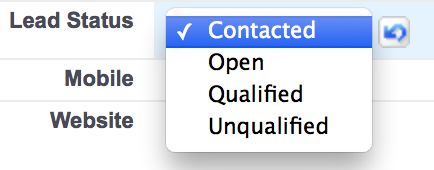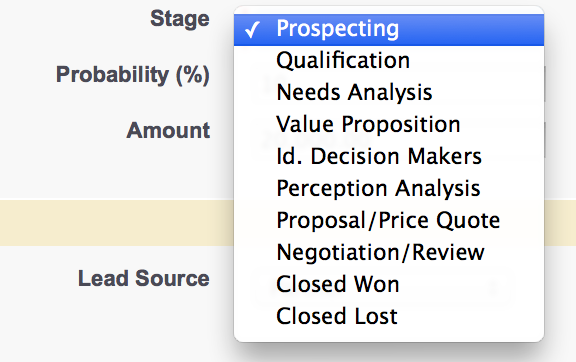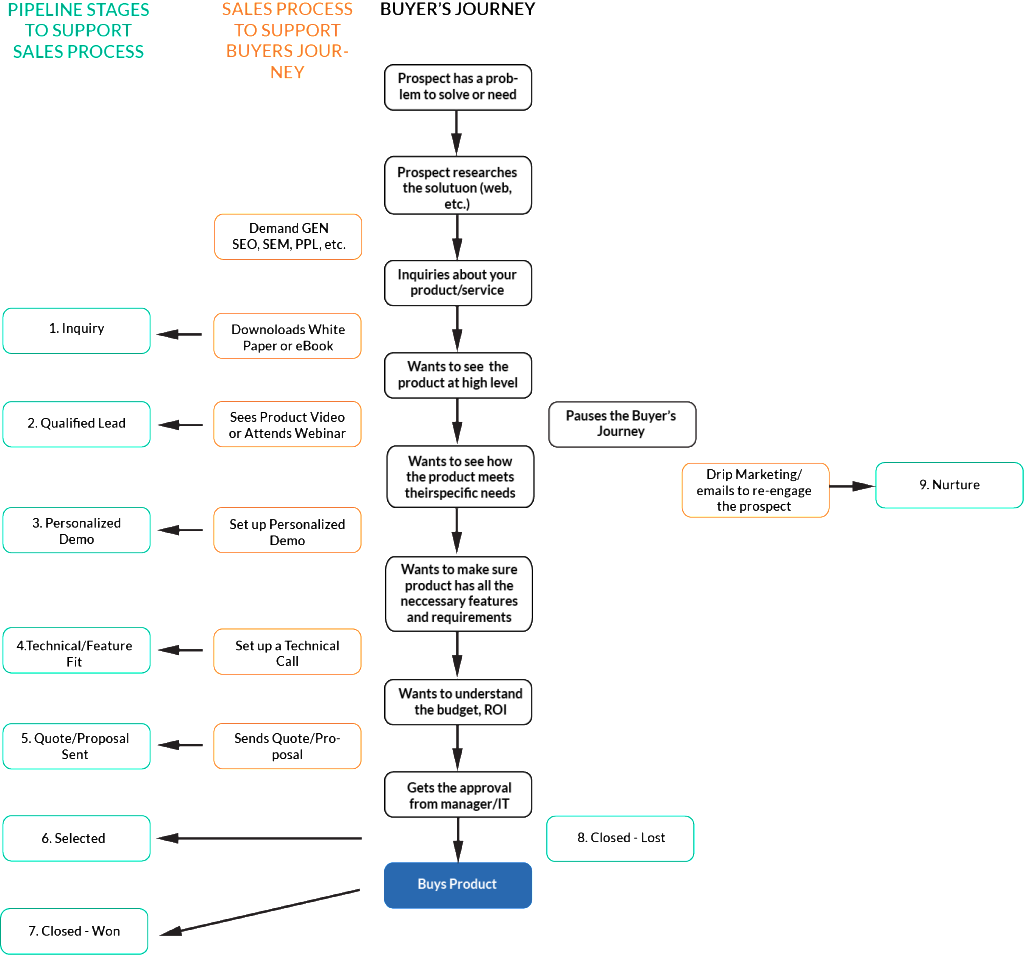Contactual was my second Startup. I had recently sold my previous company, NextAge, and started Contactual. But unlike NextAge, which relied on a field sales model, Contactual was based primarily on an inside sales distribution model. We had validated our Customer Value Proposition and like most tech startups looking to grow their inside sales team, we were looking to implement Salesforce.com to support our Sales Process. Salesforce.com came with a predefined 14 stages Sales Process that looked something like this: Leads have four types of status:
- Open

- Contacted
- Qualified
- Unqualified
Figure 1. Pre-Configured Lead Statuses in Salesforce
Opportunities have 10 stages:
- Prospecting

- Qualification
- Needs Analysis
- Value Proposition
- Identification Decision Makers
- Perception Analysis
- Proposal/Price Quote
- Negotiation/Review
- Closed – Won
- Closed – Lost
Figure 2. Pre-configured Opportunity Stages In Salesforce
The problem I had with the Salesforce.com predefined Sales Process was that I not only didn’t know what some of the stages meant, such as Perception Analysis, but I didn’t think the system worked for most B2B startups with an inside sales team. I don’t think Salesforce.com intends for any of its customers to implement their predefined Sales Process (it is just there as a preconfigured example). The sad thing is that most startups keep the predefined Sales Process the exact same way it came from Salesforce.com and never bother to modify it to reflect the specificities of their market, customers, company and product. I believe that every company that wants to build a successful B2B inside sales team has to build its very own Sales Process. The internet has changed the balance of power between the seller and the buyer. It used to be that buyers would rely on vendors to provide them with most of the information they would use to make a purchasing decision. Now with the internet the buyer has access to a lot of information before even contacting the vendor. Therefore the buyer determines the Sales Process by choosing the steps of his purchasing process, the Buyer’s Journey. Your sales process has to match your target market’s Buyer’s Journey. This forces you to analyze your target market and understand the way your prospects want to do business. Your sales cycle should make their journey easier and nudge them through the process. At Contactual, we started with an inside sales process that consisted of seven steps. Our initial sales process looked something like this:
- Inquiry
- Qualified Lead
- Prospect/Opportunity Development
- Quote Proposal/Negotiations
- Selected
- Closed – Won
- Closed – Lost
As we understood the behavior of our prospects better, we realized that some of the defined steps we were using were not objective and linked to key activity in the Buyer’s Journey (see Figure 3). In inside sales, it is important to define a clear sales process that promotes activity to move the prospects to the next stage in their Buyer’s Journey with no subjective steps. It has to be clear if an activity happens which stage your are in. It should not be a subjective decision to determine where a given deal is in the process.
“this not only increased the accuracy of our process and success rate but also sped up the Sales process as the rep was always focused on the next activity [in the inside sales process]”
We also realized that certain prospects would pause their Buyer’s Journey process, but might be interested in continuing the Journey later on. For them we added a new stage we called Nurture, which was where we would keep educating them with drip marketing, notifying them of new white papers, relevant webinars and touching them about once a month so that we would still stay on their minds.

Figure 3. Mapping of the Sales Process to the Buyer’s Journey. Please click on the image to enlarge.
Our modified system was now:
- Inquiry
- Qualified Lead
- Personalized Demo
- Technical/Feature Fit
- Quote/Proposal Sent
- Selected
- Closed – Won
- Closed – Lost
- Nurture
As we understood better our Buyer’s Journey, we replaced Prospect/Opportunity with two steps specific to our Sales Process (Personalized Demo, Technical/Feature Fit). This made it clear that if our prospect participated in a personalized demo, they were in our third step and if they confirmed that our product met their feature requirements, they were now in the fourth step. We felt this not only increased the accuracy of our process and success rate, but also sped up the Sales Process as the rep was always focused on the next activity (i.e. get Technical/Feature Fit), send a quote, etc.. We finally had a predictable, scalable process that enabled us to hire more representatives on the team, train them, and have predictable bookings along with revenue growth. Again the above Sales Process was specific to one company. Each company should regularly spend time to understand its current prospects Buyer’s Journey and define and improve its own Inside Sales Process making each step objective, activity and event based in a way to have the sales reps always focused on the next step in the process that helps the buyer go through their journey faster and more easily.
Mansour Salame
Latest posts by Mansour Salame (see all)
- The Failed Sales Plan - May 20, 2016
- What Percentage of Leads Should You Close? - April 14, 2015
- Anatomy of an Inside Sales Team: The 5 Key Parts - February 25, 2015


I think you are on track. I refe to the era in which we are selling in different ways. Buyers are Smarter, but some have a lot of information but have not always figured on where they want to go. It is also the Era of Selling I refer to as “Mass Customization for an audience of 1.”. Wwould enjoy talking about this more with you.